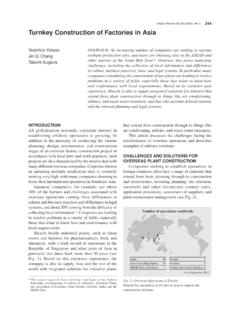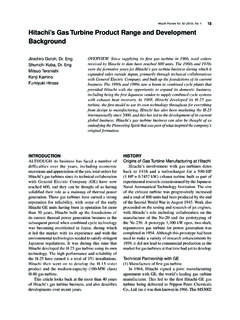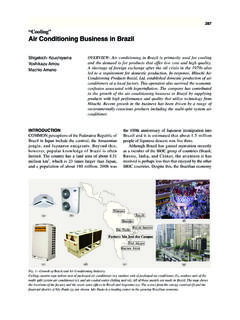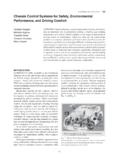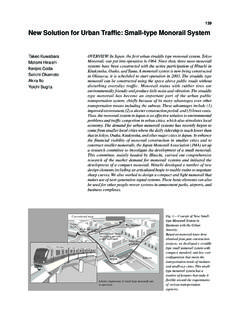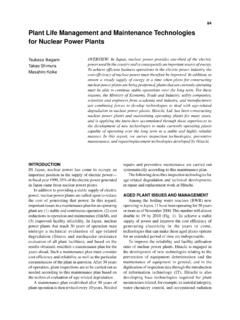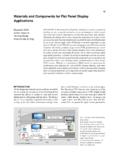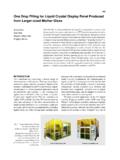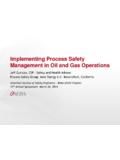Transcription of Completion of SCR System for Ninghai Power …
1 Hitachi Review Vol. 57 (2008), No. 6 293. Completion of SCR System for Ninghai Power Plant Unit 4 in China Yoshiro Inatsune OVERVIEW: The SCR System installed on Ninghai Power Plant Unit 4 of Yoshiyuki Takeuchi the Beijing Guohua Electric Power Corporation one of China's most influential Power utilities is the first NOx removal System implemented Masafumi Ishizaki on the Chinese mainland through Chinese capital investment. This SCR. System was implemented as a project set up between Babcock-Hitachi with Hitachi, Ltd. as the main contractor and Zhejiang University Energy Technology Co., Ltd. as a local partner. An order for the SCR System was accepted in January 2005, all items in the contract specifications (including DeNOx performance) were satisfied, and trial operation was completed in November 2006. In response to growth in the Chinese SCR business, Babcock-Hitachi has transferred SCR technology to three Chinese manufacturers.
2 At the end of September 2008, the Hitachi Group took the lead in the Chinese SCR market with orders received for SCR System . based on that installed at Ninghai Power Plant Unit 4 for 38 Power plants (with a total capacity of about 23,000 MW) combining SCR System and catalysts. INTRODUCTION strengthening of ambient pollution control around the SINCE introducing a commercial SCR (selective world, China's GB 13271-2001 standard Emission catalytic reduction) System on Kainan Power Station Standard of Air Pollutants for Coal-burning Oil- Unit 1 of Kansai Electric Power Co., Inc. in 1977, burning Gas-fired Boilers was introduced in China Hitachi, Ltd. and Babcock-Hitachi have delivered in 2002. In addition to the above standard, GB 13223- NOx (nitrogen oxide)-removal System designed for 2003, Emission Standard of Air Pollutants for various boiler types and fuels and introduced catalysts Thermal Power Plants, took effect in 2004, resulting at a total of more than 600 plants in Japan and overseas.
3 In further strengthening of flue gas emissions. Nowadays, dealing with environmental pollution Under these circumstances, taking the lead from in China is drawing a lot of attention. In line with the other Chinese Power companies, Beijing Guohua Fig. 1 External Appearance of the SCR. System on Beijing Guohua Electric Power Corporation Ninghai Power Plant Unit 4. The external appearance of the SCR. (selective catalytic reduction) System of Ninghai Power Plant Unit 4 is shown in photo (a). This is the first international tender from China for an SCR System . System commissioning was completed in November 2006, and the plant is currently running smoothly. The boiler for Unit 4 is shown on the far right in photo (b), and orders for SCR systems for planned (a) installation on adjacent Units 5 and 6 (each with rated Power output of 1,000 MW) have (b).
4 Also been received by Hitachi, Ltd. and Babcock-Hitachi Completion of SCR System for Ninghai Power Plant Unit 4 in China 294. Electric Power Corporation set out to implement measures against NOx emissions. Accordingly, they submitted an international tender for an NOx-removal, namely, SCR project targeting Ninghai Power Plant Unit 4. This project represented the first NOx-removal System funded with Chinese investment. After performing strict evaluation from both technical and commercial aspects, Hitachi, Ltd. and Babcock- Hitachi accepted an order under this international tender in January 2005. The rest of this report describes the SCR System installed on Ninghai Power Plant Unit 4 of Beijing Guohua Electric Power Corporation (see Fig. 1). OVERVIEW OF SCR System FOR Ninghai . Power PLANT UNIT 4. The design specifications of the SCR System are listed in Table 1.
5 Under a condition of slip NH3 of 3. ppm, a high DeNOx-efficiency of over 80% is required. The SCR reactor and ducts are shown schematically Fig. 2 Bird's-eye View of SCR Reactor and Duct. in Fig. 2. The SCR System adopts a high-dust System Flow-model testing and flow analysis were performed in order in which the SCR reactor is fitted to the boiler to devise measures for popcorn ash, exhaust-gas rectification, and layout compactization. economizer outlet. The ammonia-injection equipment is fitted in the vertical inlet duct of the SCR reactor considering allowable space. The SCR reactor is designed as a self-supporting external casing structure adopted as TABLE 1. Design Parameters for SCR System standard design of Babcock-Hitachi. The design parameters for the inlet and outlet of the SCR System A unique plate-type catalyst manufactured by of Ninghai Power Plant Unit 4 are listed.
6 Babcock-Hitachi is fitted in the SCR reactor. The System inlet catalyst layer in SCR reactor is designed as two stages Item Unit Design value and initial catalyst is installed at each stage evenly. Flue gas flow rate m3N/h-wet 1,924,795 The future catalyst is designed to install directly on Temperature C 365. each initial catalyst. By this scheme, the independent future catalyst stage is eliminated and the height of O2 Vol%-dry SCR reactor is reduced. H2O Vol%-wet Dust g/m3N-dry, act O2 FEATURES OF MAIN EQUIPMENT. NOx ppmvd, 6% O2 SCR Catalyst SO2 ppmvd, 6% O2 In order to decide the catalyst specifications, various tests have been conducted by using samples SO3 ppmvd, 6% O2 of Chinese coal and ash. The catalyst performance is System outlet greatly affected by deterioration element in the flue Item Unit Design value gas.
7 In particular, its performance is significantly NOx removal efficiency % 80 affected by dust components. The coal ash used in the NOx ppmvd, 6% O2 investigations is marked by very high concentrations Slip NH3 ppmvd, 6% O2 of CaO (calcium oxide) and Fe2O3 (ferric oxide). Since the CaO content in ash is very high, namely more than SO2 oxidation rate % 20%, several influences were expected such as, System pressure loss Pa 800. masking by calcium on the catalyst surface and Hitachi Review Vol. 57 (2008), No. 6 295. + 01. + 01. + 01. + 01. + 01. + 01. + 01. + 00. + 00. Z. + 00 Y. X. + 00. Fig. 4 External View of Ammonia Facility. The made-in-China facility was manufactured according to Fig. 3 Distribution of Flue Gas Flow in SCR Reactor Chinese standard based on a Japanese proved design. Simulated by CFD (computational fluid dynamics).
8 Based on the CFD results, the flow model test was also conducted to verify the final results. against this popcorn ash. That is to say, the cross- section of inlet upward duct was expanded in order to deterioration of the catalyst activity, and plugging of decrease gas flow velocity, popcorn ash was collected catalyst. Further, the Fe2O3 in ash is one of the factors in a hopper at the bottom of the duct, and popcorn ash of increasing SO2 oxidation rate. inflow into the reactor was prevented. Given these factors, on selecting the specification To confirm the effect of this countermeasure and for the catalyst, we adopted a new catalyst that verified to study the uniform distribution of the flue gas velocity good anti-CaO performance and low SO2 oxidation in the entire SCR System , CFD (computational fluid rate, in light of its good performance record when used dynamics) was carried out.
9 The CFD results are shown with similar types of coal in the USA. In a parallel- in Fig. 3. These CFD results were positively verified plate form, the catalyst has the characteristic that it by a flow-model test using a physical model. is highly resistant to dust plugging. Furthermore, in this project, regarding the pitch of the SCR catalyst, Ammonia Facility anti-blockage measures were strengthened by adopting As for the ammonia facility, although it had shown a larger catalyst pitch than that conventionally used good performance in China at ammonia synthesis (7 mm compared to 6 mm). As mentioned below, the plants, refrigeration stations, and so on, the ammonia effectiveness of these high plugging resistant measures facility developed by this project represented the first was verified. And further effect of widening the catalyst facility, which had been used for an SCR System .
10 Given pitch was to decrease the pressure loss. The pressure that fact, a proposal to design the facility, based on a loss across the catalyst layers was decreased by 30% proved Japanese design, to meet Chinese design in comparison with that of a conventional catalyst. As standards was put forward and built by local a result, the Power consumption of flue gas fan could manufacturers. Consisting of a compressor for intake, be reduced. a storage tank, a vaporizer, an accumulator, and so on, the ammonia facility is a dual System in compliance SCR Reactor and Flue Gas Duct with customer specifications (see Fig. 4). When larger particle dust generated in the boiler furnace (that is, popcorn ash) flows over the SCR OPERATIONAL STATUS. catalyst, ash accumulates on the catalyst layers, Performance-test Results causing problems such as decreased catalyst After 168-h continuous operation test, performance performance, increased pressure loss, and erosion of testing was conducted from May to June 2007 under the catalyst due to local increases in gas flow velocity.
